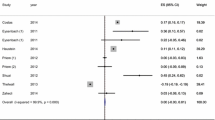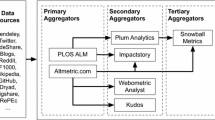Abstract
Altmetric Attention Score (AAS) is an increasingly popular composite altmetric measure, which is being criticized for an inappropriate and arbitrary aggregation of different altmetric sources into a single measure. We examined this issue empirically, by testing unidimensionality and the component structure congruence of the five ‘key’ AAS components: News, Blogs, Twitter, Facebook, and Google+. As a reference point, these tests were also done on different citation data: WoS, Scopus, and Google Scholar. All tests were done for groups of articles with: (1) high citations, but lower AAS (HCGs), and (2) high AAS, but lower citations (HAGs). Changes in component structures over time (from 2016 to 2017) were also considered. Citation data consistently formed congruent unidimensional structures for all groups and over time. Altmetric data formed congruent unidimensional structures only for the HCGs, with much inconsistency for the HAGs (including change over time). The relationship between Twitter and News counts was shown to be curvilinear. It was not possible to obtain a satisfactory congruent and reliable linear unidimensional altmetric structure between the groups for any variable combination, even after Mendeley and CiteULike altmetric counts were included. Correlations of altmetric aggregates and citations were fairly inconsistent between the groups. We advise against the usage of composite altmetric measures (including the AAS) for any group comparison purposes, until the measurement invariance issues are dealt with. The underlying pattern of associations between individual altmetrics is likely too complex and inconsistent across conditions to justify them being simply aggregated into a single score.

Similar content being viewed by others
Notes
Note that we expressed mean citations as a log-transformed average of WoS, Scopus, and Google Scholar citation counts. Using combined citations was justified given the high unidimensionality and congruence of citation data from these sources, as shown in the Unidimensionality and congruence tests section of the Results. The log-transformation was used to account for highly non-normal distributions.
In fact, even several examinations of differences between groups in the AAS and citations done at the beginning of the Results is, strictly speaking, not justified due to later established incongruence.
References
Adie, E., & Roe, W. (2013). Altmetric: Enriching scholarly content with article-level discussion and metrics. Learned Publishing, 26(1), 11–17.
Bornmann, L. (2014). Validity of altmetrics data for measuring societal impact: A study using data from Altmetric and F1000Prime. Journal of Informetrics, 8(4), 935–950.
Bornmann, L. (2015). Alternative metrics in scientometrics: A meta-analysis of research into three altmetrics. Scientometrics, 103(3), 1123–1144.
Chen, F. F. (2007). Sensitivity of goodness of fit indexes to lack of measurement invariance. Structural Equation Modeling, 14(3), 464–504.
Cohen, J. (1992). A power primer. Psychological Bulletin, 112(1), 155–159.
Development Core Team, R. (2005). R: A language and environment for statistical computing [Computer Software]. Austria: R Foundation for Statistical Computing.
Drasgow, F. (1984). Scrutinizing psychological tests: Measurement equivalence and equivalent relations with external variables are the central issues. Psychological Bulletin, 95(1), 134–135.
Dunlap, W. P. (1994). Generalizing the common language effect size indicator to bivariate normal correlations. Psychological Bulletin, 116(3), 509–511.
Erdt, M., Nagarajan, A., Sin, S. C. J., & Theng, Y. L. (2016). Altmetrics: an analysis of the state-of-the-art in measuring research impact on social media. Scientometrics, 109(2), 1117–1166.
Ferrando, P. J., & Lorenzo-Seva, U. (2017). Assessing the quality and appropriateness of factor solutions and factor score estimates in exploratory item factor analysis. Educational and Psychological Measurement. https://doi.org/10.1177/0013164417719308.
Galligan, F., & Dyas-Correia, S. (2013). Altmetrics: Rethinking the way we measure. Serials Review, 39(1), 56–61.
Glänzel, W., & Gorraiz, J. (2015). Usage metrics versus altmetrics: Confusing terminology? Scientometrics, 102(3), 2161–2164.
Gorraiz, J., Gumpenberger, C., & Schlögl, C. (2014). Usage versus citation behaviours in four subject areas. Scientometrics, 101(2), 1077–1095.
Grice, J. W. (2001). Computing and evaluating factor scores. Psychological Methods, 6(4), 430–450.
Gumpenberger, C., Glänzel, W., & Gorraiz, J. (2016). The ecstasy and the agony of the altmetric score. Scientometrics, 108(2), 977–982.
Haustein, S., Peters, I., Bar-Ilan, J., Priem, J., Shema, H., & Terliesner, J. (2014). Coverage and adoption of altmetrics sources in the bibliometric community. Scientometrics, 101(2), 1145–1163.
Horn, J. L. (1965). A rationale and test for the number of factors in factor analysis. Psychometrika, 30(2), 179–185.
Kline, P. (2010). Handbook of psychological testing (2nd ed.). London: Routledge.
Kousha, K., & Thelwall, M. (2007). Google Scholar citations and Google Web/URL citations: A multi-discipline exploratory analysis. Journal of the American Society for Information Science and Technology, 58(7), 1055–1065.
Lorenzo-Seva, U., & Ferrando, P. J. (2006). FACTOR: A computer program to fit the exploratory factor analysis model. Behavior Research Methods, 38(1), 88–91.
Lorenzo-Seva, U., & Ferrando, P. J. (2013). FACTOR 9.2: A comprehensive program for fitting exploratory and semiconfirmatory factor analysis and IRT models. Applied Psychological Measurement, 37(6), 497–498.
Lorenzo-Seva, U., & Ten Berge, J. M. (2006). Tucker’s congruence coefficient as a meaningful index of factor similarity. Methodology, 2(2), 57–64.
McDonald, R. P. (1999). Test theory: A unified treatment. Mahwah, NJ: Erlbaum.
McGraw, K. O., & Wong, S. P. (1992). A common language effect size statistic. Psychological Bulletin, 111(2), 361–365.
Meredith, W. (1993). Measurement invariance, factor analysis and factorial invariance. Psychometrika, 58(4), 525–543.
Mongeon, P., & Paul-Hus, A. (2016). The journal coverage of Web of Science and Scopus: A comparative analysis. Scientometrics, 106(1), 213–228.
Nuredini, K., & Peters, I. (2016). Enriching the knowledge of altmetrics studies by exploring social media metrics for Economic and Business Studies journals. EconStor Conference Papers, ZBW—German National Library of Economics. Retrieved from http://EconPapers.repec.org/RePEc:zbw:esconf:146879.
O’Reilly, T. (2005). What is web 2.0? Design patterns and business models for the next generation of software. Retrieved from http://www.oreilly.com/pub/a/web2/archive/what-is-web-20.html?page=1.
Ortega, J. L. (2015). Relationship between altmetric and bibliometric indicators across academic social sites: The case of CSIC’s members. Journal of Informetrics, 9(1), 39–49.
Priem, J., Taraborelli, D., Groth, P., & Neylon, C. (2010). Altmetrics: A manifesto. Retrieved from http://altmetrics.org/manifesto/.
Reise, S. P., Widaman, K. F., & Pugh, R. H. (1993). Confirmatory factor analysis and item response theory: Two approaches for exploring measurement invariance. Psychological Bulletin, 114(3), 552–566.
Ronald, R., & Fred, Y. Y. (2013). A multi-metric approach for research evaluation. Chinese Science Bulletin, 58(26), 3288–3290.
Subotić, S. (2013). Pregled metoda za utvrđivanje broja faktora i komponenti (u EFA i PCA) [Review of methods for determining the number of factors and components to retain (in EFA and PCA)]. Primenjena Psihologija, 6(3), 203–229.
Sud, P., & Thelwall, M. (2014). Evaluating altmetrics. Scientometrics, 98(2), 1131–1143.
Tabachnick, B. G., & Fidell, L. S. (2013). Using multivariate statistics (6th ed.). Boston, MA: Pearson.
Thelwall, M., Haustein, S., Larivière, V., & Sugimoto, C. R. (2013). Do altmetrics work? Twitter and ten other social web services. PLoS ONE, 8(5), e64841.
Tucker, L. R. (1951). A method for synthesis of factor analysis studies (Personnel Research Section Report No. 984). Washington, DC: Department of the Army.
Vandenberg, R. J., & Lance, C. E. (2000). A review and synthesis of the measurement invariance literature: Suggestions, practices, and recommendations for organizational research. Organizational Research Methods, 3(1), 4–70.
Vaughan, L., & Shaw, D. (2005). Web citation data for impact assessment: A comparison of four science disciplines. Journal of the Association for Information Science and Technology, 56(10), 1075–1087.
Velicer, W. F. (1976). Determining the number of components from the matrix of partial correlations. Psychometrika, 41(3), 321–327.
Wang, X., Fang, Z., & Sun, X. (2016). Usage patterns of scholarly articles on Web of Science: A study on Web of Science usage count. Scientometrics, 109(2), 917–926.
Wouters, P., & Costas, R. (2012). Users, narcissism and control—Tracking the impact of scholarly publications in the 21st century. Utrecht: SURF foundation.
Wu, A. D., Li, Z., & Zumbo, B. D. (2007). Decoding the meaning of factorial invariance and updating the practice of multi-group confirmatory factor analysis: A demonstration with TIMSS data. Practical Assessment Research and Evaluation, 12(3), 1–26.
Zinbarg, R. E., Revelle, W., Yovel, I., & Li, W. (2005). Cronbach’s α, Revelle’s β, and McDonald’s ω H : Their relations with each other and two alternative conceptualizations of reliability. Psychometrika, 70(1), 123–133.
Zwick, W. R., & Velicer, W. F. (1986). Comparison of five rules for determining the number of components to retain. Psychological Bulletin, 99(3), 432–442.
Author information
Authors and Affiliations
Corresponding author
Rights and permissions
About this article
Cite this article
Mukherjee, B., Subotić, S. & Chaubey, A.K. And now for something completely different: the congruence of the Altmetric Attention Score’s structure between different article groups. Scientometrics 114, 253–275 (2018). https://doi.org/10.1007/s11192-017-2559-8
Received:
Published:
Issue Date:
DOI: https://doi.org/10.1007/s11192-017-2559-8




